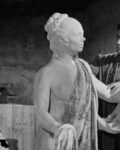BR: Satan Never Sleeps (1962)
 Film: Good
Film: Good
Transfer: Excellent
Extras: Good
Label: Twilight Time
Region: All
Released: December 18, 2018
Genre: Drama
Synopsis: An itinerant priest becomes enmeshed in a clash between a struggling Catholic mission and Mao’s advancing Red Army in 1949.
Special Features: Isolated Mono Music & Effects Track / Theatrical Trailer / 8-page colour booklet with liner notes by film historian Julie Kirgo / Limited to 3000 copies / Available exclusively from Screen Archives Entertainment and www.twilighttimemovies.com.
Review:
Whether Pearl S. Buck’s first screenplay required heavy work by Claude Binyon isn’t known, but the author of The Good Earth (published in 1931, and made into a film in 1937 by MGM) reportedly wrote China Story around 1950, after which longtime Warner Bros. producer Hal B. Wallace bought the property. In 1960, Leo McCarey nabbed the rights and produced the film in 1962, the last of three films for Twentieth Century-Fox.
McCarey’s career was built on writing & directing a string of classics – Duck Soup (1933), Ruggles of Red Gap (1935), Going My Way (1944) – but he also became a little notorious for his anti-Communist stance, which materialized in the Red Menace classic My Son John (1952). It would be five years until his next film, the Fox weepy An Affair to Remember (1957) reestablished the filmmaker’s hit-making status and politically neutral stories, after which came Rally Round the Flag, Boy! (1958).
Now, the luridly titled Satan Never Sleeps is a very weird, highly uneven drama that occasionally pauses for broad comedic bits before its very serious tale of an itinerant priest in a withering Catholic mission in Communist China gets kicks in, and McCarey is able to indulge in critiques of evil, despotic Maoist Communism.
Heading towards his new post as village priest, Father O’Banion (William Holden) rides a donkey with spunky, teenage-ish Siu Lan (France Nuyen), a waif whose life he saved and whose presence irritates him to no end because of an eternal gratitude that ensures Siu will never, ever be far away from her savior.
O’Banion manages to separate himself from Siu and reaches the parish of Father Bovard (longtime Fox star Clifton Webb, in his final feature film), a fussy priest who’s just trying to maintain a fair balance of moral teaching and benevolence with parishioners as Mao’s Red Army creeps closer during the November 1949 campaign, like a vile plague quashing and pillaging missions of their medicine, food, medicinal libations, and tinned stocks for the good of the People.
Webb, looking much older than his suave appearance in Boy on a Dolphin (1957), veers from an initially irate to frustrated patriarch when he’s forced to return to the religious compound by Chung Ren (Robert Lee), the former altar boy who’s now the local military chief, magistrate, and sleazebag.
McCarey builds Ren as a once sensitive boy whose found power and a venue for revenge with the communists, and although there’s early chiding by Bovard and the nuns as they recall his boyhood antics in front of his men, the tone turns nasty when Ren has soldiers rip out religious symbols, furnishings, and fabrics for a public bonfire, and after the altar’s torn and turfed, drape massive banners sporting the iconic red star logo and Mao’s mug. The Orwellian transformation is almost complete when virtually every parishioner abandons the church, save for Ren’s parents – stubborn, pious, and brave souls who remain a thorn in his backside.
Medicine, supplies, and stashed alcohol are claimed for the people, and he comes close to claiming Siu for what clearly would’ve been a rapefest in his car or some discrete location. Ren’s ugly deed is seeded when Bovard recovers from a hunger strike and a fettered O’Banion is forced to listen next-door.
As the priests survive under increasing pressure, Ren’s health worsens from a knife wound courtesy of defiled Siu, but rather than show gratitude towards the priests, he double-crosses and pressures them to sign and participate in public renunciations of their faith, branding Catholicism as an abomination.
Amid these incredibly heavy-handed plot twists are moments of lightness, either through banter or slight comedy, sometimes wrought from bad cooking, or more often Siu’s constant hovering around O’Banion; her infatuation with an older and holy man irks Bovard, and until the sexual assault, her persistence and periodic sneaking in and out of his bedroom are treated by McCarey as moments of ingénue cheekiness.
Nuyen’s characterization of Siu, perhaps meticulously directed by McCarey, has her grinning at every opportunity, and Nuyen’s physical performance certainly conveys a flighty teen deeply fixated on Holden’s portrayal of a bad boy priest; his uniform is often semi-covered by a worn fighter pilot jacket. Burt Kwouk (Kato in the long-running Pink Panther series) is forced to smile and grin a great deal due to his servant character’s lack of English.
Ren’s quite content living in the splendorous manor of the former magistrate, and attempts to force the priests into signing refutations of their faith and the church’s deliberate ploy to deceive the village, but Bovard’s stubbornness and hunger strike breaks Ren, summoning a superior and, most amusingly, a Soviet advisor / meddlesome apparatchik (Martin Benson) who chastises and repeats policy. Bovard is soon tortured, but Ren’s fidelity to the movement is hacked away by ceding power to his peers, his parents’ literal iconic deaths, and in an unsurprising turn of events, the realization he’s the father of Siu’s son.
An escape is choreographed, an act of self-sacrifice enables the three survivors to reach Hong Kong, where Ren proudly sees his son baptized by O’Banion, now that Siu has a husband and family of her own.
Ren’s preposterous shift from commie wannabe to soul saved from the Red Menace should collapse when he discovers parenthood, but as one-note as the character may have been written, Lee does a fine job navigating through a series of clichéd scenes, perhaps because he aptly conveys the soul of an immature man mishandling the responsibilities of power, and his cruelties motivated by a childish inability to handle any kind of criticism. He is the perfect baby despot, enjoying the spoils of conquest, and making faux promises even when his health is faltering from a series of sadistic and stupid decisions.
If Bovard is the good Christian whose experience, wisdom, and bravery make him the perfect savior for the fleeing group, then O’Banion is the appropriate hero, learning from Bovard, and surviving by wits and a mordant, dry sense of humour – qualities that make him ideal for 20th century, urban parishioners, especially those with prior moral distractions and ideologically tainted endeavors; if anyone can keep the ex-commie and the brat together for the good of the child, it’s O’Banion.
Lore has it that McCarey grew unhappy with the production and left prior to its completion, leaving veteran assistant director / second unit director David Orton to wrap up the loose and leftover scenes. Oswald Morris’ cinematography is beautiful, but this is very much a British-based production, using some of the sets from Fox’s prior Asian hit Inn of the Sixth Happiness (1958).
Most of the matte paintings in wide shots are fine, but the very first scenes are part of an incredibly sloppy series of rear projection shots: two similar takes of O’Banion tugging a mule with Siu on top cast shadows on the screen over which a badly lit valley backdrop is assimilated; and in a later scene between the slightly older & wiser pair, the seam of looped lake footage repeats in the similar badly lit background. Even the end scene has the cast placed against a poor rear projected cathedral interior.
Whether limited post-production time, poor lab work, or laziness were to blame, they’re glaring technical gaffes in a film that’s otherwise beautifully lit and composed by Morris (Moby Dick, Our Man in Havana, The Dark Crystal) in CinemaScope, and crisply transferred to HD by Fox.
Composer Richard Rodney Bennett (Billion Dollar Brain, Murder on the Orient Express, Enchanted April) probably found the film’s tonal shifts tough to score, and he was forced to adapt Harry Warren’s title theme, featuring ridiculous lyrics co-written by McCarey. Twilight Time’s Blu-ray features an isolated mono music & effects track, which should please Bennett’s fans, as the score proper was never commercially released.
Although there’s no audio commentary, Julie Kirgo’s liner notes offer a more tender appreciation of the film, citing its quirks as virtues by a director with a string of classic dramas, comedies, weepies, and musicals.
The trailer illustrates Fox’s attempt to figure what they had, and the montage of scenes culminates in an extract from a mob assault that infers an epic battle sequence (which it isn’t).
Note the ad campaigns of the era, and Fox’s DVD which ups the bullshit factor:

Although the eyelines don’t match the unsubtle suggestion that William Holden (O’Banion) and France Nuyen (Siu) have steamy, drippy sex, the art direction puts SEX far above the main story of two priests fighting against evil Communist atheism. Priest #2, Clifton Webb (Bovard), is barely recognizable by Holden’s earlobe.

Very 1960s poster campaign that geometrically evokes O’Banion’s struggle to remain faithful to the church or indulge in forbidden love. Or quit smoking?

Fox Home Video’s rear DVD art that shows actress France Nuyen looking serious in a moment that never happens, and in a dress she never wears. I call Bullshit!
Author Pearl S. Buck adapted her script into a novel published in tandem with the film’s release. Other feature films based on her writings include Dragon Seed (1944), China Sky (1945), The Big Wave (1961), Guide (1965), and Pavillion of Women (2001).
Robert Lee made several appearances on TV (The Tomorrow People, Hawaii Five-O, Mind Your Language), including “Mark of the Devil,” an episode of Hammer House of Mystery and Suspense (1984) which also had a small part for Bert Kwouk.
France Nuyen had appeared in Fox’s South Pacific (1958), In Love and War (1958), and Man in the Middle (1964), the latter offering a more mature albeit smaller role. Feature film roles became much fewer, and she would appear in a multitude of TV series (Trapper John, M.D., St. Elsewhere, Knots Landing) between Battle for the Planet of the Apes (1973) and China Cry: A True Story (1990).
© 2019 Mark R. Hasan
External References:
Editor’s Blog — IMDB — Composer Filmography
Vendor Search Links:
Amazon Canada
— Amazon USA
— Amazon UK
Category: Blu-ray / DVD Film Review

















Connect